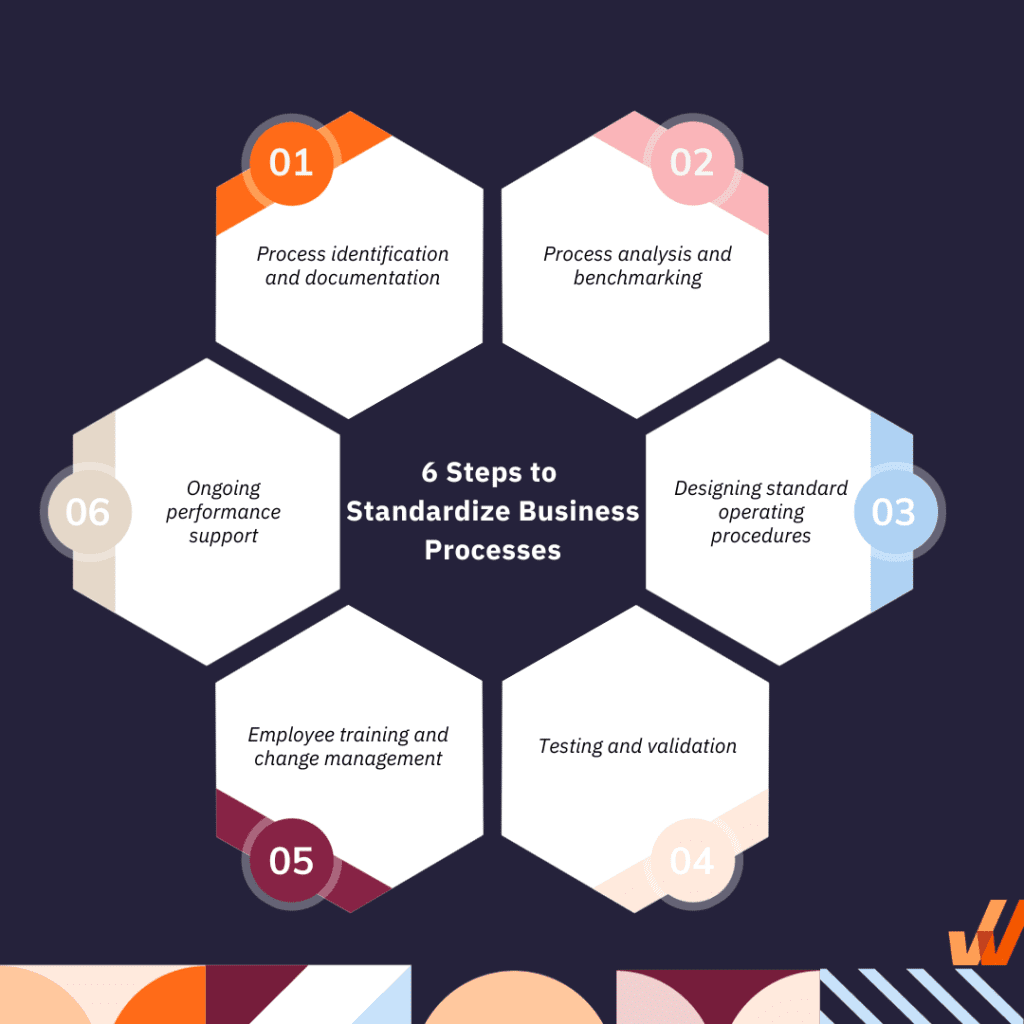
Disha Gupta


Successful organizations depend on efficient and streamlined operational business processes to improve efficiency, meet compliance, and empower employees. However, every area of business has unique responsibilities and tasks, which leads to variations in approaches to problem-solving and process design. This can create redundancies and silos that can bog down operations.
Process standardization helps organizations avoid these problems by allowing for the development of unified and consistent procedures and processes that simplify work for employees and maximize business outcomes.
Process standardization is establishing consistent, uniform business procedures and process documentation for performing specific tasks. Through this process, organizational leaders identify how teams approach similar problems and establish a singular, optimal solution to be implemented across the board. These new, standardized procedures, sometimes called standardized operational procedures (SOPs), eliminate redundancies, strengthen quality control measures, and reduce risk.
Standardization of operational processes is fundamental to building an efficient organization. The benefits of effective process standardization include:
By standardizing operations, business leaders can be confident that processes are carried out consistently and the results of those processes are not only predictable but high-quality. Because SOPs are designed using best practices, their implementation leads to improved quality of products and services and even higher customer satisfaction.
Similarly, the nature of streamlining processes brings about increased efficiency as employees waste less time and fewer resources. This allows them to do better work in less time, further contributing to increased productivity across the organization through better process efficiency.
When operational processes are straightforward and streamlined, training employees on SOPs becomes much quicker and easier. Reducing redundancies and unnecessary aspects of operations leads to fewer training hurdles, allowing employees to learn the ins and outs of their roles without complication.
Establishing clear, efficient SOPs makes it easier to monitor KPIs and benchmarks and improve processes as the need arises. Facilitated process analysis is also imperative for SOPs that need to comply with industry or government regulations and standards.
With transparent, standardized business processes and methods of procedures, organizations can analyze business processes to identify areas of friction and optimize these procedures to create optimal business processes that are the most efficient.
Because every business is essentially a complex series of interworking operational processes, process standardization can become an equally complex undertaking. Operational leaders can get the standardization process started by following these steps:

Begin by pinpointing the particular operations that need to be standardized. Depending on the organization’s size, this list could have many processes. You can use process documentation tools to record existing processes and bring in subject matter experts and employees who carry out these processes to provide insight into problem areas.
Flowcharts, written procedures, and business process maps are helpful tools for outlining existing processes and highlighting areas for improvement.
From here, your team can dig into your documentation to determine which processes involve the most redundancies or bottlenecks. This helps you establish KPIs and benchmarks to measure future improvement. These process standards include cost savings, error rates, or customer satisfaction.
Next, lay out new, optimized versions of your processes to develop improved standard operating procedures (SOPs). If possible, work out uniform solutions that can be applied to several procedures simultaneously.
These SOPs must be clear and concise to reduce error and confusion upon implementation. They should include simple step-by-step instructions and point to any relevant documentation or resources employees need when carrying them out.
✓ Thank you, the checklist will be sent to your email
Finally, it’s time to put your new, standardized procedures into practice. Roll things out on a smaller scale at first to closely monitor your KPIs and validate the effectiveness of the changes being implemented.
Use workflow automation and quality control software to ensure that employees adhere to new SOPs and provide abundant opportunities for feedback to collect feedback and adjust as necessary. By building this feedback loop, your team can continuously improve processes as they are rolled out across the organization.
SOPs will naturally affect employees and how they are expected to perform at work. To minimize change-related discomfort, employees should be made aware of upcoming changes and their importance and provided with any necessary change management or upskill training to help them adjust to new processes.

After the new standardized procedures are fully implemented, they should regularly be reviewed to ensure they remain optimal for the organization’s needs and industry best practices. As a business grows and changes, SOPs should be revised to match.
You should also provide continuous performance support to your employees to help them navigate these processes effectively and to help them overcome challenges and issues when they arise.
Standardizing procedures can bring organizations many benefits, but there are common obstacles that may accompany this process, including:
When team members are informed that they need to change the way they do their jobs, it is common for them to feel uncomfortable or even irritated. To combat employee concerns and internal resistance to change, organizational leaders should take the time to communicate the details of new SOPs and the benefits their implementation will bring. By providing the necessary support, business leaders can ensure that the transition to using the new, standardized processes goes smoothly.
While designing unified solutions to similar problems across an organization can increase efficiency, it is essential to leave room for flexibility and creativity. Remember this while standardizing procedures, and work in some space for changing business needs or unique situations.
In some industries, especially ones regulated by government agencies, operating procedures need to adhere to strict rules. This should be top of mind when designing new SOPs, ensuring procedures remain compliant even if it prevents total efficiency or unification of approaches.
Process standardization can benefit organizations in a variety of industries:
In the manufacturing industry, standardized processes guarantee that every single product a company makes meets the same specifications and quality standards. This consistency ensures that products meet the expectations of customers as well as regulating bodies. In the manufacturing industry, standardized processes also include best safety practices that ensure employees avoid unnecessary risks at work, minimizing accidents and injuries in the workplace.
Overall, process standardization empowers manufacturers to succeed and deliver high-quality products to their customers.
In the retail world, efficiency and customer satisfaction are especially vital to organizational success. Standardized processes ensure consistency and optimization in customer experience and loss prevention, as well as inventory and supply chain management. They also play a large role in facilitating employee onboarding and training to ensure they are uniformly well-versed in operational procedures, company policies, and customer service standards.
Process standardization allows retailers to deliver customer and employee experiences that ensure they can stay competitive in a highly competitive industry.
Standardizing operating procedures in the healthcare sector allows service providers to offer exemplary patient care while optimizing operations and maintaining regulatory compliance. In this industry, standardized processes reduce the risk of errors to improve patient safety and allow practitioners to offer consistently high-quality care. They can also reduce patient healthcare costs by minimizing waste, reducing inefficiencies, and ensuring accurate and optimal billing practices.
The healthcare sector ultimately relies on process standardization to achieve positive outcomes for patients and generally improve the effectiveness of healthcare services.
Here are some best practices that will ensure your process standardization efforts are successful.
When designing standardized processes, bring in key stakeholders like subject matter experts, managers, and the employees who will actually perform them. Each of these types of stakeholders will bring an important perspective to the conversation.
Overhauling every single process in an organization at once may not be feasible, or even ideal. It is often best to start by standardizing unique processes, or ones that are most in need of optimization. When implementing standardized processes across the organization, it is also ideal to start in one area of business and roll out changes in other departments once it has proven to be effective.
Regularly monitor standardized processes to ensure adherence by team members and make improvements as necessary. Collect feedback from employees and review KPIs to determine where updates can be made.
Regularly monitor standardized processes to ensure adherence by team members and make improvements as necessary. Collect feedback from employees and review KPIs to determine where updates can be made.
Digital adoption platforms (DAPs) are valuable tools that empower organizations to standardize processes through in-app guidance and self-help support. By providing guided flows and interactive support, DAPs help organizations implement standardized procedures, ultimately reducing training efforts and building a culture of continual improvement.
DAPs such as Whatfix also enable organizations to analyze these processes and workflows to identify friction points, create optimal user paths, and engage employees with better experiences.
To learn more about Whatfix, click here to schedule a free demo with us today!
Thank you for subscribing!